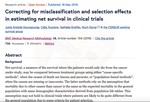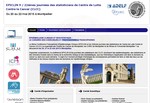Correcting for misclassification and selection effects in estimating net survival in clinical trials
In conclusion, the new RBS model allows estimating net survival in clinical trials. It corrects the biases of cause-of-death misclassification and of selection effect on the expected mortality in the general population. This makes it particularly useful in clinical trials with long follow-ups. With the RBS model, the researcher obtains accurate estimates of the excess hazard and, therefore, of net survival; however, he/she should check the strong assumption of homogeneous selection. Finally, the RBS model paves the way for new methodological developments in the field of net survival methods in multicenter clinical trials.
Commentary on 'Survival benefit of mantle cell lymphoma patients enrolled in clinical trials; a joint study from the LYSA group and French cancer registries'.
Click the Cite button above to demo the feature to enable visitors to import publication metadata into their reference management software.
Impact of socioeconomic inequalities on geographic disparities in cancer incidence - comparison of methods for spatial disease mapping
In spatial analysis of cancer incidence, SpODT and HBSM may be used not only for cluster detection but also for searching for confounding or etiological factors in small areas. Moreover, the multivariate HBSM offers a flexible and meaningful modeling of spatial variations; it shows plausible previously unknown associations between various cancers.
Impact des inégalités socioéconomiques sur les variations spatiales de l’incidence du cancer en Isère - comparaison de méthodes de détections de clusters spatiaux
(Introduction) Plusieurs méthodes statistiques permettent d’évaluer l’impact d’un facteur sur la répartition spatiale d’une maladie donnée. Cependant, leur fiabilité est souvent remise en question et des variations spatiales réelles peuvent être confondues à celles issues d’un bruit statistique, surtout lorsque les indicateurs sanitaires sont disponibles à une échelle très fine mais très variable comme celle des communes. Lorsque les incidences sont cartographiées, les comparaisons d’incidence entre aires géographiques ne sont valides que lorsque certains tiers facteurs, associés à la survenue de la maladie, ne diffèrent pas significativement entre les unités spatiales. Dans le domaine du cancer, plusieurs études ont démontré qu’il existe un lien entre les variations géographiques de certains cancers et le niveau socioéconomique des individus. L’objectif de notre travail était d’évaluer l’impact de la prise en compte d’un indicateur du niveau socioéconomique dans la détection de clusters spatiaux de cancers, en comparant, de manière empirique, différentes méthodes.




